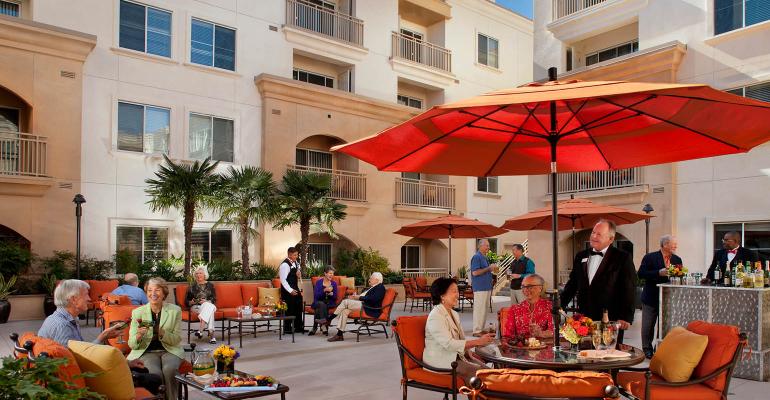Key takeaways from the NIC MAP third quarter 2017 seniors housing data release include the following:
- Seniors housing occupancy remained unchanged at 88.8 percent.
- Annual growth rates for both assisted living inventory and absorption reached record highs in the third quarter.
- Eleven markets saw gains in inventory of more than 10 percent.
- Same-store rent growth decelerated.
- Closed transaction volume accelerated in the third quarter.
Let’s take a closer look at some of these trends.
Seniors housing occupancy unchanged at 88.8 percent
- The all occupancy rate for seniors housing, which includes properties still in lease up stage, was 88.8 percent in the third quarter, unchanged from the second quarter. This placed occupancy 1.9 percentage points above its cyclical low of 86.9 percent reached during the first quarter of 2010 and 1.4 percentage point below its most recent high of 90.2 percent in the fourth quarter of 2014. For the four quarters ending in the third quarter, there were 23,000 units added to inventory, versus 16,000 units absorbed. As a result, occupancy fell 60 basis points from the third quarter of 2016.
- Stabilized occupancy for all seniors living properties (defined by NIC as properties that have been open for at least two years or, if open for less than two years, have already reached a 95 percent occupancy level) was higher than total occupancy and stood at 90.3 percent in the third quarter, also unchanged from last quarter and down 60 basis points from year-earlier levels. It is notable that the difference between total occupancy and stabilized occupancy was 140 basis points, down from 160 basis points last quarter, but still quite wide. The size of this gap reflects the large number of properties recently opened and still in the lease up stage.
Annual growth rates for both assisted living inventory and absorption reached record highs in the third quarter
- Assisted living inventory growth in the primary markets (largest 31 CBSAs in the nation) has been ramping up for a longer period than independent living and as of the third quarter, annual inventory growth for majority assisted living properties reached its highest level since NIC began reporting the data in 2006—6.5 percent. This has put significant downward pressure on occupancy, which stood at 86.6 percent in the third quarter. Annual absorption also accelerated in the third quarter and came in at a 5.1 percent pace. That made annual absorption also the highest rate since NIC began reporting the data.
- For majority independent living properties in the primary markets, inventory growth exceeded absorption by 70 basis points in the third quarter—at 2.4 percent versus 1.7 percent. The third quarter pace of year-over-year inventory growth was a bit weaker than in the second quarter when it posted a 2.7 percent gain, the strongest pace since mid-2009. The occupancy rate for majority independent living properties was 90.5 percent in the third quarter.
Eleven markets saw gains in inventory of more than 10 percent
- During the past year, there have been nearly 38,000 units added to the stock of seniors housing inventory among the primary and secondary markets (largest 99 CBSAs in the nation). Roughly one quarter of this growth occurred in seven metropolitan areas: Dallas, Chicago, Minneapolis, Atlanta, Phoenix, Austin, Texas and Miami. Dallas alone accounted for 7.0 percent of all new seniors housing inventory in the past 12 months.
- Relative to each metropolitan area’s own inventory, there were 11 geographies that experienced gains in inventory of more than 10 percent over the course of the year. They include New Orleans, Charleston, S.C., Baton Rouge, La., Salt Lake City, Austin, El Paso, Texas, Albuquerque, N.M., San Antonio, Jacksonville, Fla., Greenville, S.C. and Ogden, Utah.
Same-store rent growth decelerates
- Same-store asking rent growth for seniors housing slowed in the third quarter, with year-over-year growth of 2.7 percent. This was down from 3.4 percent in the first half of this year, and was near the 2.6 percent average pace experienced since late 2006.
- Asking rent growth for majority assisted living properties was 2.4 percent for the third quarter, down 70 basis points from the second quarter. For majority independent living, rent growth decelerated to 2.5 percent from 3.7 percent in the second quarter and down from 4.2 percent in the third quarter, when rent growth reached its highest pace since NIC began collecting this data.
- There is wide variation in rent growth. Los Angeles rents increased by 4.7 percent from year-earlier levels, while San Jose, Calif. was up by 5.4 percent. At the other end of the spectrum was Kansas City, which saw rents fall by 0.2 percent.
Closed transaction volume picked up in third quarter
- The third quarter saw a significant uptick in closed transaction volume. Seniors housing and care transactions volume totaled $4.6 billion in the third quarter, which is the sum of $1.3 billion in seniors housing sales and $3.3 billion in nursing care. The total volume was up 113 percent from the previous quarter’s $2.2 billion. However, it was down slightly from the third quarter of 2016, when volume came in at $4.7 billion.
- At $15 billion, the rolling four-quarter total seniors housing and care volume was flat compared with the second quarter.
Beth Burnham Mace serves as chief economist and director of outreach with the National Investment Center for Seniors Housing and Care (NIC).
0 comments
Hide comments

